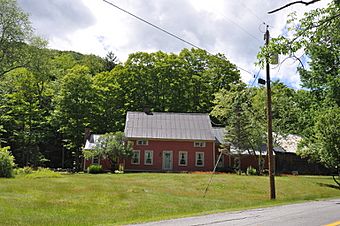Houghtonville Historic District facts for kids
Quick facts for kids |
|
|
Houghtonville Historic District
|
|
 |
|
| Location | Houghtonville, Stagecoach & Cabell Rds., Grafton, Vermont |
|---|---|
| Area | 218 acres (88 ha) |
| NRHP reference No. | 15000583 |
| Added to NRHP | September 8, 2015 |
The Houghtonville Historic District is a special area in Grafton, Vermont. It protects a group of old homes that show what an early industrial area used to look like. This district is found west of Grafton Village on Houghtonville Road. It has ten well-kept houses from the 1800s. Some of these homes are on land where old mills once stood. The district was added to the National Register of Historic Places in 2015. This means it is an important place to preserve.
History of Houghtonville
The area around Grafton was first officially set up in 1754. But people only started living there for good in the late 1770s. This happened in the town's Middletown section. The main part of Grafton Village grew where two parts of the Saxtons River meet. This river flows into the Connecticut River.
Houghtonville is about 3 miles (4.8 km) up the North Branch Saxtons River from Grafton Village. It grew around a mill and homes built by the Houghton family. These mills worked throughout the 1800s. They finally closed in the early 1900s. The small village also had a post office and a schoolhouse. Both of these buildings are still standing today. In the 1910s and 1920s, some of the older houses were fixed up. People used them as summer homes.
Exploring the District
The historic district stretches west along Houghtonville Road. It starts from where Houghtonville Road meets Cabell Road. It goes past the meeting point with Stagecoach Road. The district also includes properties a short way up Stagecoach Road.
You can also find an early concrete bridge across the river on Cabell Road. This bridge was built around 1921. Some records suggest it might have been built after the New England Hurricane of 1938. There is some debate about the exact date.
The district includes three large farm properties. Their big fields help keep the area feeling rural and natural. Most of the other buildings are on smaller pieces of land close to the road. The district also has the old remains of two mills. These mills were very important for the village's economy long ago.



